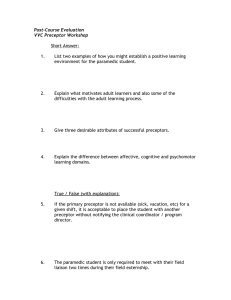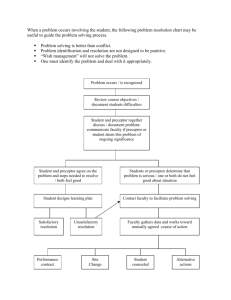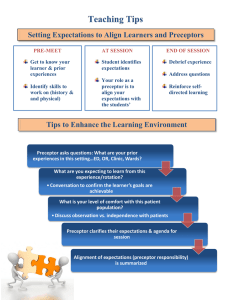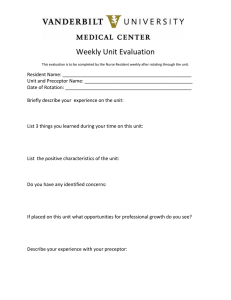Preceptor Power Point
advertisement
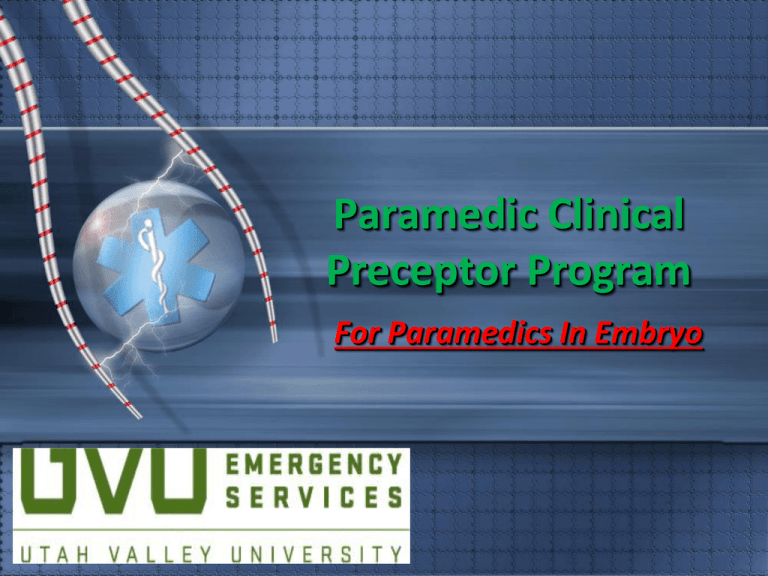
Paramedic Clinical Preceptor Program For Paramedics In Embryo Paramedic Clinical Preceptor Purpose To prepare the experienced Paramedic for his/her role as a trainer of Paramedic students. To Provide A mechanism for identifying EMS students who do not meet minimum performance standards prior to certification. UVU Paramedic Clinical Preceptor Paramedic Clinical Preceptor - means a Utah certified paramedic with a minimum of two years of emergency medical services experience who meets the standard requirement for paramedic preceptor training as established by the UVU Paramedic Program. UVU Paramedic Clinical Preceptor While in training preparatory to becoming certified, paramedic trainees may perform any of the functions specified under the direct supervision of a duly licensed physician, a registered nurse, or an approved Paramedic Clinical Preceptor. Success of the Preceptorship Success of a preceptorship is determined by the relationship between the student and the preceptor. Students look to preceptors for answers and guidance. Preceptors are an extension of the classroom. Role of a Preceptor Support students to make them feel they are safe and valued Demonstrate by example how competent staff perform their job Know and appreciate the student’s knowledge level Remember what it was like to be a student yourself Facilitate learning rather than controlling it Preceptor directs the process of learning Student sets the pace of learning Direct, coach, support, and delegate Be willing to provide constructive and regular feedback on student’s performance Be responsible for the student for the entire shift the student is scheduled Preceptor Bill of Rights All preceptors have the RIGHT to: • Be treated with dignity and respect • Be free from intimidation or harassment • Expect their students to discuss and/or demonstrate core knowledge • Expect their student will be eager to learn • Expect their student will initiate questions • Be creative in student instruction • Report student deficiencies they perceive • Be free from the threat or act of retribution Student Bill of Rights All students have the RIGHT to: • Be treated with dignity and respect • Be free from intimidation or harassment • Make mistakes; have a preceptor who is able to correct and/or intervene • Expect their preceptor wants to teach • Expect fair and impartial evaluations • Expect fair and reasonable answers to questions • Not be subjected to inappropriate situations • Report situations to appropriate supervisor without threat of retribution or retaliation Laws of Learning Individuals accept and repeat responses that are pleasant First impressions are lasting Repetition yields habit Skills not practiced are forgotten Dramatic experiences leave lasting impressions Adult Learners Characteristics Self-directed Are motivated by their desires Want to participate in planning and evaluation Relate current experience to previous experiences Want to be heard Want their efforts acknowledged Want to be treated with respect and dignity Environment Conducive to Learning Display mutual respect Collaborate; don’t compete Have open, two way communication Feedback is encouraged and enhances growth Feedback needs to be concurrent, immediate and shared in a manner void of blame or personal attacks Feedback should never be provided as a put down Student Development Students are in a process of developing entry level knowledge, skills and behaviors Student development is a gradual phased progression Orientation and a plan outlining activities and expectations for the rotation should be reviewed Students appreciate the opportunities to participate in activities and learn from observing practices of more experienced colleagues Let’s Talk About… Patricia Brenner and Benner’s Theory: From Novice to Expert Patricia Benner, R.N., P.h.D., FAAN,F.R.C.N. Patricia Benner is a Professor in the Department of Physiological Nursing in the School of Nursing at the University of California, San Francisco. Dr. Benner received her bachelor's degree in nursing from Pasadena College, her master's degree in medical surgical nursing from the University of California, San Francisco, and the Ph.D. from the University of California, Berkeley, in Stress and Coping and Health under the direction of Hubert Dreyfus and Richard Lazarus. Knowledge development in a practice discipline consists of extending practical knowledge (know-how) through theory based scientific investigations and through the clinical experience in the practice of that discipline” (Benner, 1984) Dr. Benner’s Theory Dr. Benner categorized nursing into 5 levels of capabilities: novice, advanced beginner, competent, proficient, and expert. She believed experience in the clinical setting is key to nursing because it allows a nurse to continuously expand their knowledge base and to provide holistic, competent care to the patient. Her research was aimed at discovering if there were distinguishable, characteristic differences in the novice’s and expert’s descriptions of the same clinical incident. Even though she is a NURSE… These concepts totally apply to what Preceptors do when teaching Paramedics! Benner’s Theory: From Novice to Expert 1. 2. 3. 4. 5. Novice Advanced Beginner Competent* Proficient Expert * (goal of entry level) Benner, P (1982) From Novice to Expert. AJN 82( 3), 402-407 Capability of Novice Student Participate in orientation program(s) Perform in an observational role Demonstrate competency of BLS skills Possess a general knowledge base Be able to follow directions Be dependable Possess an attitude open to learning Capability of Advanced Beginner Begins to focus on ALS Skills Model behaviors observed Additional responsibilities added if student can demonstrate they can handle more and are approved through the training program and are functioning within their scope of practice Overall patient management should be the responsibility of the preceptor Competency (goal of entry level) Proficient Paramedic Student Focuses on overall patient management Demonstrates team leadership skills Demonstrates evaluation completed thoroughly and with accurate assessment Delegates tasks to other team members Capability for accurate treatment, transportation decisions, effective communication Displays confidence, performs with authority Demonstrates flexibility and professionalism Duties and Responsibilities of a Paramedic Preceptor Objectives List eight responsibilities of a clinical preceptor. Identify the most important duty of the clinical preceptor. Identify the five characteristics of an effective preceptor. Duties and Responsibilities of a Paramedic Preceptor Maintain appropriate and adequate patient care during the training experience. Provide a positive role model for the Paramedic student. Maintain a continuity of classroom instruction to the field environment. (Pair core knowledge with the patients they see) Assist the trainee in making the transition from classroom to the field environment. (Make ‘em show what they know) Duties and Responsibilities of a Paramedic Preceptor Provide FEEDBACK... It should be: Constructive Specific Frequent Valid Maintain a PROFESSIONAL demeanor. Lead by example. Duties and Responsibilities of a Paramedic Preceptor Each call is a new opportunity. Focus on current situation and move past previous mistakes. Guide, monitor and evaluate the student’s performance to assure successful completion and identify those who need remediation. Keep accurate and complete records. (Paperwork will be covered at the end of the presentation.) Five Characteristics of an Effective Paramedic Preceptor 1) Has a strong desire to EDUCATE as well as TRAIN 2) Is technically proficient 3) Has PATIENCE 4) Can inspire motivation and is communicative 5) Has maturity and is respectful The Most Important Duty of the Clinical Paramedic Preceptor BE POSITIVE Provide the AND student… PROFESSIONAL a ROLE MODEL *** Laws of Learning *** Individuals accept and repeat responses that are pleasant. First impressions are lasting. Repetition yields habit. Skills not practiced are forgotten. Dramatic experiences leave lasting impressions. Characteristics of Adult Learning Self-directed Participate in planning and evaluation Related to previous experience Establishment of Environment Conducive to Learning Mutual respect Collaborate *DO NOT* Compete Open lines of communications between preceptor and student Offer feedback… encourages and enhance growth Everyone is HUMAN… another ACRONYM HUMAN H = Hear them out U = Understand their feelings M = Motivate their desires A = Acknowledge their efforts N = Never put them down, make personal attacks, display harsh or blaming attitudes Role of the Preceptor in the Learning Environment … Acts as a facilitator of learning rather than a controller of learning. … Directs the process of learning while the student sets the pace, ask questions, and controls the learning. Providing Feedback Start with positive feedback Find something to say! Reinforces behaviors and encourages repetition Needs to be timely Needs to be objective Needs to be constructive What was done right What opportunities for improvement are evident Needs to be documented to provide continuity throughout the learning process Providing Feedback should be information that helps people to decide whether their behaviors have had the intended effects. Start with POSITIVE feedback… even if all the student did right was not fall down. Positive Feedback… Re-enforces BEHAVIORS and ENCOURAGES REPETITION of those behaviors by communicating that they had the intended effects. Negative Feedback… …discourages behaviors by communicating that they did not have the intended effects Principles of Giving Feedback Intention Recipient open to feedback Changed behavior Behavior vs. Generalities Describe Behavior Personal Impact Accept responsibility Understanding Encouragement Principles of Receiving Feedback Be specific in what you ask Don’t act defensively or rationalize the behavior at issue Summarize your understanding Share your thoughts and feelings Communication Stoppers • Interrupting • Ridiculing or blaming • Ignoring/denying feelings or ideas • “Mind-Reading” or assuming • Controlling • Ordering/commanding Rating Errors …errors in judgment that occur in a systematic manner when an individual observes and evaluates another. What makes these errors so difficult to correct? Most Common Rating Errors Contrast Effect …the tendency for a rater to evaluate a person relative to other individuals rather than on the standard. Most Common Rating Errors First Impression …the tendency for a rater to make a first favorable or unfavorable judgment and ignore or distort any further information. Most Common Rating Errors Halo Effect …improper vague judgments from one part of the job performance to all other areas or parts of the job. Most Common Rating Errors Similar - To - Me - Effect …tendency to judge more favorably those whom the rater sees similar to themselves. Most Common Rating Errors Central Tendency …this occurs when people want to “just play it safe” …everyone “meets standards” Most Common Rating Errors Negative and Positive Leniency These errors are committed by a rater who is either too hard or too easy in rating students. Positive leniency may raise unfounded expectations… while Negative leniency may cause the feeling of inadequacy. Trouble-Shooting Performance Problems 1. 2. 3. 4. Is there a problem? What is the problem? Is the problem important? Where has the system broken down? Clinical Paperwork As you well know, documentation is a critical part of EMS. As part of the certification process, the Regional Training Coordinators will review the documentation weekly to keep informed of the student progress prior to course completion to ensure that all state requirements have been met. UVU students will bring the “clinical bluebook” with them every shift they ride. In this “clinical bluebook” will be several forms that you, as preceptors, will need to complete for them. They will also be on line for your convenience. The following slides will show you each piece of documentation required. Clinical Paperwork https://www.uvu.edu/esa/academics/para medic.html Thank You!!! • • • • • Once you have completed the program, please email me at sallred@uvu.edu with the following information: Name Mailing address Original date of certification Utah EMT or Paramedic number List of current certifications (ACLS, PHTLS, PALS, etc) You may submit a resume instead if you like I will forward a program summary form for you to complete and email back to me. Once that is completed, then I will mail you a copy of the Clinical Preceptor Training Record Form for your records. I will let you know the status of that as soon as I know it. WE REALLY APPRECIATE ALL YOU DO! Proctors make a difference! Thank You! UVU Paramedic Program 50
